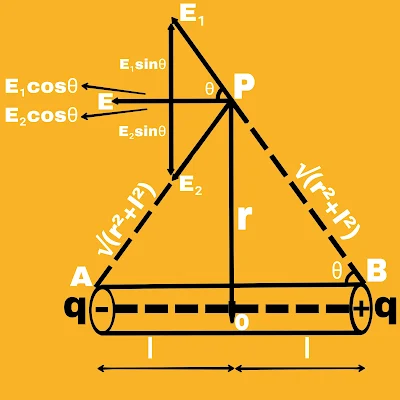The intensity of electric field due to electric dipole
The intensity of the electric field caused by an electric dipole is determined is two situations:
Consider the electric dipole whose dipole moment is P. The intensity of the electric field at a point P situated at a distance r from the centre of the dipole is to be calculated.
The intensity of electric field at point P due to +q charge
E₁ = [1/4π€0].q/(r+l)²]
Similarly,
The electric field intensity at point P due to -q charge
E₁ = [1/4π€0].q/(r-l)²]
The intensity of resultant electric field at point P.
E = E₂-E₁
E = [1/4π€0].q/(r-l)²]-[1/4π€0].q/(r+l)²]
E = q/4π€0[1/(r-l)²-1/(r+l)²]
E = q/4π€0[{(r+l)²-(r-l)²}/(r²-l²)²]
E = q/4π€0[4rl/(r²-l²)²]
Since,
r >> l
Therefore,
E = q/4π€0[4rl/r⁴]
E = 2/4π€0[2ql/r³]
E= 1/4π€0[2P/r³]
From electric dipole (P=2ql)
The intensity of electric field at point P due to +q charge
E₁ = [1/4π€0].q/(r+l)²]
Similarly,
The electric field intensity at point P due to -q charge
E₁ = [1/4π€0].q/(r-l)²]
The intensity of resultant electric field at point P.
E = E₂-E₁
E = [1/4π€0].q/(r-l)²]-[1/4π€0].q/(r+l)²]
E = q/4π€0[1/(r-l)²-1/(r+l)²]
E = q/4π€0[{(r+l)²-(r-l)²}/(r²-l²)²]
E = q/4π€0[4rl/(r²-l²)²]
Since,
r >> l
Therefore,
E = q/4π€0[4rl/r⁴]
E = 2/4π€0[2ql/r³]
E= 1/4π€0[2P/r³]
From electric dipole (P=2ql)
2. Axial position of electric dipole


Consider the electric dipole whose dipole moment is P. From O to the midpoint of the dipole. The electric field at a point P located at a distance is to be calculated in the axisymmetric position.
The intensity of electric field at point P due to +q charge
E₁ = [1/4π€0].q/(r²+l²)] in the direction of PB
Similarly,
The intensity of electric field at the point P due to -q charge
E₂ = [1/4π€0].q/(r²+l²)] in the direction of PA
The intensity of resultant electric field at point P.
E = E₁cosθ + E₂cosθ
E₁ = E₂
E = 2E₁cosθ
E = 2.[1/4π€0].q/(r²+l²)].l/√(r²+l²)
E = [1/4π€0].P/(r²+l²)^3/2
Hense,
l << r
E = [1/4π€0].p/r³
Note
Electric field intensity due to a point charge
E ∝ 1/r²
Electric field intensity due to an electric dipole
E ∝ 1/r³
The intensity of electric field at point P due to +q charge
E₁ = [1/4π€0].q/(r²+l²)] in the direction of PB
Similarly,
The intensity of electric field at the point P due to -q charge
E₂ = [1/4π€0].q/(r²+l²)] in the direction of PA
The intensity of resultant electric field at point P.
E = E₁cosθ + E₂cosθ
E₁ = E₂
E = 2E₁cosθ
E = 2.[1/4π€0].q/(r²+l²)].l/√(r²+l²)
E = [1/4π€0].P/(r²+l²)^3/2
Hense,
l << r
E = [1/4π€0].p/r³
Note
Electric field intensity due to a point charge
E ∝ 1/r²
Electric field intensity due to an electric dipole
E ∝ 1/r³
Read more...

0 Comments
Post a Comment